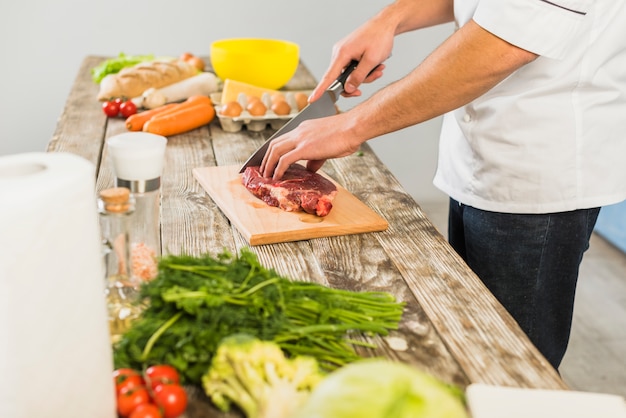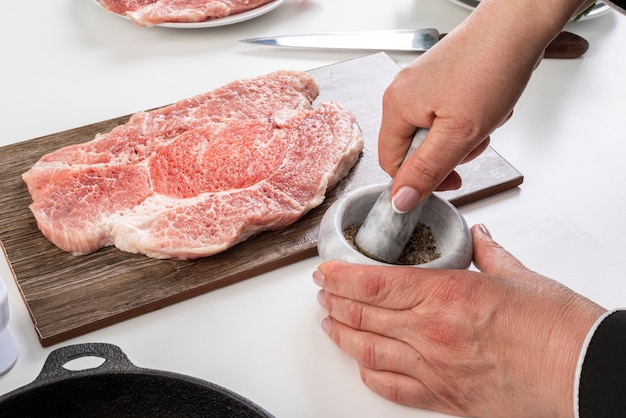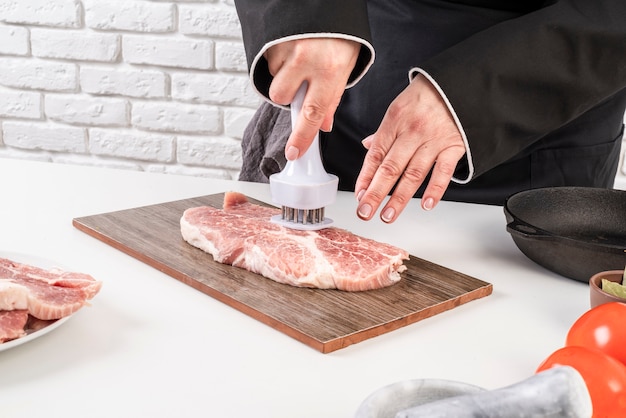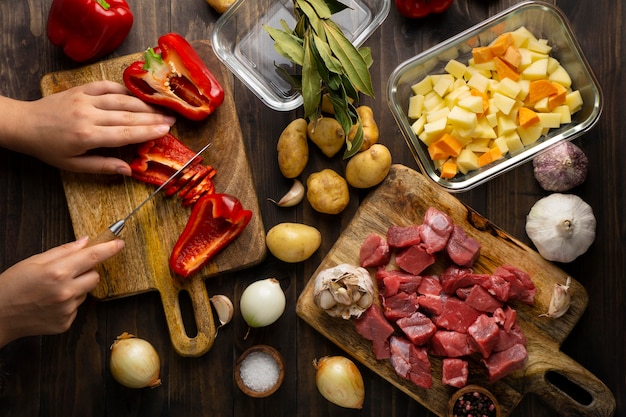Alright, you've decided to take the plunge and cook your own steak. You've got the grill fired up, a juicy piece of meat, and a craving for a delicious meal. But before you go tossing that steak onto the hot coals, you need to figure out how long to cook it for. This is where the real art of steak cooking comes in, and it's a journey I've been on for years, learning from countless burnt, overcooked, and sometimes shockingly perfect steaks. So, let's dive in, shall we?
Part 1: The Importance of the internal temperature

Setting the Scene: My Steak Journey
Let's be honest, for a long time, my idea of a "perfectly cooked steak" was anything that wasn't raw. I'd throw it on the grill, flip it a few times, and pray for the best. But that led to some pretty disastrous results. You know, the kind that leave you with a charred exterior and a cold, unyielding interior? Not exactly the gourmet experience I was hoping for.
Then, I stumbled upon the magic of a meat thermometer. It was like a revelation! Suddenly, I could actually control the internal temperature of my steak, ensuring that it was cooked to my exact liking. That's when my steak journey really took off. I started learning about different cuts, different cooking methods, and the importance of resting the meat. It was like a whole new world of deliciousness opened up.
The Importance of Internal Temperature
Now, here's the thing about steak: it's not just about how long you cook it. It's about the internal temperature. See, that's where the magic happens. Each steak cut has a specific internal temperature range that gives you the desired level of doneness. Whether you prefer a rare, medium-rare, medium, medium-well, or well-done steak, knowing the right internal temperature is key.
And trust me, once you get it right, the difference is incredible. No more dry, rubbery steaks! You'll get a juicy, tender steak that just melts in your mouth. It's truly a game-changer.
Think about it this way. Imagine biting into a perfectly cooked steak. The exterior is crispy and flavorful, while the inside is juicy and tender. The meat is pink and succulent, not dry and rubbery. That's the magic of knowing the right internal temperature. You can achieve that perfect balance of doneness and texture, creating a truly memorable steak experience.
Part 2: The Doneness Guide: Cracking the Code

Deciphering the Doneness
Alright, let's break down the different levels of doneness and the corresponding internal temperatures for a 1-inch thick steak. This is where things get a little technical, but don't worry, I'll keep it simple.
Remember, these are just guidelines. Your personal preference might differ, and that's perfectly okay! The key is to find what you like and stick with it.
- Rare: 125-130°F (52-54°C) - The steak will have a bright red center and be very soft and tender. This is for those who enjoy a truly raw center, almost bordering on blue.
- Medium-Rare: 130-135°F (54-57°C) - This is my personal favorite. The steak will have a slightly pink center and a more firm texture than rare. This is the "golden standard" for many steak enthusiasts, offering a balance of flavor and tenderness.
- Medium: 135-140°F (57-60°C) - The center of the steak will be mostly brown, with just a hint of pink. The texture is firmer than medium-rare but still juicy. It's a good middle ground for those who like some pink but not a lot.
- Medium-Well: 140-145°F (60-63°C) - The center will have a very slight pink hue and will be fairly firm. The pink is barely noticeable, with most of the meat cooked through. This is a good choice for those who want a cooked steak but still a touch of juiciness.
- Well-Done: 145-150°F (63-66°C) - The steak will be completely brown throughout, with a firm texture. This is for those who prefer their steak cooked thoroughly, with no hint of pink. It's important to note that well-done steaks can be quite dry, so be prepared for that texture.
My Doneness Experience
Now, I've been through all the stages of steak doneness. I used to think that medium-rare was a bit too raw, but then I realized that it's the perfect balance of tenderness and flavor. It's that juicy, succulent, melt-in-your-mouth experience that I crave. Plus, let's be real, the pink center just looks so good! But if you're not a fan of pink meat, then medium or medium-well might be your go-to.
The key is to experiment and find what suits your taste. Just remember, there's no right or wrong answer when it comes to steak doneness. It's all about personal preference.
I've even had moments where I've overcooked a steak to well-done, and although it was edible, it was a bit dry and chewy. It definitely wasn't the satisfying experience I was hoping for. So, learning the importance of internal temperature and finding that perfect balance of doneness for you is a journey of exploration and discovery.
Part 3: The Grill: A Hot and Fiery Friend

Grill Time: Choosing Your Weapon
Okay, so you've got your steak and you know how you want it cooked. Now, it's time to fire up the grill. I'm a big fan of grilling. It gives that beautiful char and smoky flavor that you just can't get with any other cooking method. But before you throw your steak onto the flames, there are a few things to consider.
Setting the Stage: High Heat vs. Low Heat
Grilling a steak is all about temperature control. You want to get that perfect sear on the outside while keeping the inside juicy and tender. There are two main approaches you can take:
- High Heat: This is for the bold and adventurous. You'll sear the steak on high heat for a shorter period, achieving a crispy crust. This method works best for thinner steaks. The intense heat creates a quick sear, locking in the juices and developing a delicious crust.
- Low Heat: This is the more patient approach, requiring lower temperatures and longer cooking times. This is perfect for thick steaks because it allows for even cooking without burning the outside. The gentle heat allows the steak to cook through evenly, resulting in a tender and flavorful steak.
My Grill Experience: High Heat and Patience
My personal preference leans towards high heat, with a touch of patience. I love the intense flavors and the crispy texture that come from searing a steak over high flames. However, I've learned to keep an eye on the time and adjust the heat accordingly. You don't want to end up with a burnt exterior and a raw center.
The key is to find a balance between heat and time. Experiment with different temperatures and cooking times to see what works best for you and your steak.
Remember, a good grill will give you a good sear, but it's also important to maintain the right temperature throughout the cooking process. Don't be afraid to adjust the heat as needed, especially if you're cooking a thicker steak. You might need to move the steak to a cooler part of the grill to avoid overcooking it. It's all about finding that sweet spot of heat and time.
Part 4: Mastering the Flip: A Technique for Success
The Art of the Flip
Now, here's where it gets interesting. Flipping a steak isn't as simple as you might think. It's not just about flipping it over and calling it a day. There's a whole technique involved, and it's crucial for achieving a perfectly cooked steak.
The One-Flip Technique
My go-to method is the one-flip technique. This is where you sear the steak for a specific amount of time on one side, then flip it over and cook it for the same amount of time on the other side. This ensures that the steak cooks evenly and prevents it from getting overcooked on one side.
But here's the catch: you need to make sure that the steak is properly seared on the first side before you flip it. This means that the steak should have a nice crust and be slightly brown. If you flip it too early, you won't achieve that perfect sear, and you might end up with a bland and soggy steak.
My Flip Experience: The One-Flip Mastery
I've spent countless hours honing my one-flip technique. I've learned to judge the sear, to know when the steak is ready to be flipped. It's a delicate balance of heat, time, and intuition. And once you master it, you'll feel like a real steak maestro.
Remember, the key is to avoid flipping the steak too often. Each time you flip it, you interrupt the cooking process, which can lead to uneven cooking and a less flavorful steak. So, be patient and let the steak cook through on each side before you flip it.
Some people advocate for multiple flips, but I find that the one-flip method provides the most consistent results. It's a technique that requires patience and observation, but once you get it right, you'll be rewarded with a beautifully cooked steak.
Part 5: Resting: The Key to Juicy Perfection
Let It Rest: The Importance of Patience
So, your steak is cooked to perfection. You've got that beautiful sear, and you can't wait to dig in. But wait! Before you slice into that juicy goodness, there's one crucial step you need to take: rest it. That's right, resting your steak is as important as cooking it.
The Science Behind Resting
Think of it this way: when you cook a steak, the juices get pushed to the outside. But if you cut into it immediately, those juices will escape, leaving you with a dry, tough steak. By resting the steak, you allow the juices to redistribute throughout the meat, resulting in a much more tender and flavorful steak.
Resting Times: Patience is a Virtue
The recommended resting time for a 1-inch thick steak is 5-10 minutes. But don't worry, it's not as long as it sounds. You can use this time to prepare your sides or grab a drink. Just make sure to cover the steak with foil to keep it warm and prevent it from drying out.
My Resting Experience: Patience Pays Off
I used to be impatient and couldn't wait to cut into my steak. But after learning the importance of resting, I've become a patient steak enthusiast. I've learned that those extra few minutes make all the difference. My steaks are now much juicier, more flavorful, and incredibly tender.
So, trust me, resting your steak is not an optional step. It's a critical part of the process that ensures a truly perfect steak. Be patient, and your taste buds will thank you. Just imagine those flavorful juices settling back into the meat, resulting in a steak that is incredibly tender and flavorful.
Part 6: Slicing: A Skill to Master
The Art of Slicing: A Crucial Step
Your steak is cooked, rested, and ready to be sliced. But before you grab your knife, take a moment to appreciate the beautiful color and texture of your masterpiece. It's a work of art, and slicing it requires a touch of finesse.
Slicing Tips: Making it Easy
Here are a few tips to ensure that you slice your steak perfectly:
- Use a sharp knife. A dull knife will tear the steak, resulting in uneven slices. Invest in a good quality chef's knife, one that is sharp and comfortable to hold. It will make the slicing process much easier and more enjoyable.
- Slice against the grain. This means slicing perpendicular to the muscle fibers. This will make the steak more tender and easier to chew. You can identify the grain by looking at the pattern of the steak. The muscle fibers will run in a certain direction. Slice across those fibers, and you'll be rewarded with a tender steak.
- Slice thin. Thin slices allow the flavors to develop and make the steak more tender. A good rule of thumb is to slice the steak about 1/4 inch thick. It's best to err on the side of thinner slices, as thicker slices can be harder to chew.
- Keep the steak warm. Don't let the steak get cold before you slice it. This will make it tougher to slice. Once you've rested your steak, keep it covered with foil to maintain the heat.
My Slicing Experience: From Novice to Master
I remember the first time I tried to slice a steak. It was a disaster. The slices were uneven, the steak was tough, and it just looked messy. But with practice, I've learned to slice a steak with precision and care. It's a skill that takes time to master, but it's worth the effort. A perfectly sliced steak adds a touch of elegance to any meal.
So, don't be afraid to experiment with different slicing techniques. Try slicing the steak at different angles, different thicknesses. You'll be amazed at the difference it can make in the texture and flavor of your steak. Practice makes perfect, so don't be discouraged if your first few slices aren't perfect.
Part 7: The Perfect side dish: A Delicious Companion
Completing the Meal: The Perfect Pairing
Okay, your steak is cooked to perfection, rested, and sliced beautifully. Now it's time to find the perfect companion. I'm talking about a side dish that complements the flavors of your steak and creates a truly unforgettable meal. Think of it as the supporting cast that enhances the starring role of your steak.
Side Dish Options: Exploring the Possibilities
The possibilities are endless when it comes to side dishes, but here are a few classics that I always find myself reaching for:
- mashed potatoes: Creamy, comforting, and perfect for soaking up the juices from your steak. Mashed potatoes are a classic pairing for a reason. They provide a comforting contrast to the rich flavors of the steak.
- Roasted Vegetables: A colorful and healthy addition to your plate, with flavors that complement the steak perfectly. Roasted vegetables provide a burst of color and flavor, complementing the steak with a touch of freshness.
- Asparagus: A simple yet elegant side dish that pairs well with the rich flavors of the steak. Asparagus adds a touch of elegance to the plate, its delicate flavors complementing the steak perfectly.
- grilled corn on the Cob: Sweet, smoky, and bursting with flavor, this is a perfect summer companion for your steak. Grilled corn on the cob is a quintessential summer side dish, adding a sweet and smoky flavor that complements the steak beautifully.
- Mushroom Risotto: A creamy and earthy side dish that adds a touch of sophistication to your meal. Mushroom risotto is a sophisticated choice, providing a creamy and earthy texture that contrasts well with the steak.
My Side Dish Experience: Seeking Flavor Harmony
I've tried countless side dishes over the years, but I always find myself coming back to the classics. They're reliable, flavorful, and they complement the steak so well. But don't be afraid to experiment. Try pairing your steak with a side dish that you've never tried before. You might just discover your new favorite combination.
A good side dish should complement the flavors of the steak, not overpower them. Think about the balance of flavors, textures, and colors when choosing your side dish. You want to create a harmonious meal, where each element enhances the others.
Part 8: The Finishing Touches: Elevating the Experience
Adding a Touch of Magic: Sauces and Seasonings
Your steak is cooked perfectly, your side dish is ready to go, and the aroma of grilling fills the air. But there's one last touch that can elevate your meal from good to truly extraordinary. I'm talking about sauces and seasonings.
Sauce Options: A Symphony of Flavors
A good sauce can add a burst of flavor and moisture to your steak. Here are a few classics that I always have on hand:
- Béarnaise Sauce: A classic French sauce made with egg yolks, butter, and herbs. It's rich, creamy, and adds a touch of elegance to any steak. Béarnaise sauce is a rich and flavorful sauce that perfectly complements the richness of a steak.
- Red Wine Sauce: A robust sauce made with red wine, shallots, and herbs. It's perfect for pairing with a rich steak like ribeye or strip steak. Red wine sauce adds a depth of flavor to the steak, enhancing its richness and complexity.
- Peppercorn Sauce: A tangy and spicy sauce made with black peppercorns, butter, and cream. It's a great option for those who like a bit of heat with their steak. Peppercorn sauce adds a spicy kick to the steak, making it a bold and flavorful choice.
- Garlic Butter Sauce: A simple yet delicious sauce made with garlic, butter, and herbs. It's a perfect choice for adding a touch of flavor and moisture to your steak. Garlic butter sauce is a classic choice, providing a flavorful and aromatic touch to the steak.
Seasoning Options: Spice Up Your Life
Seasonings are the finishing touch that can really take your steak to the next level. Here are a few of my favorites:
- Salt and Pepper: The classic and essential seasonings for any steak. Salt and pepper are the foundation of any steak seasoning, enhancing the natural flavors of the meat.
- Garlic Powder: Adds a touch of savory flavor. Garlic powder provides a subtle but impactful savory note to the steak.
- Onion Powder: Provides a subtle sweetness and depth of flavor. Onion powder adds a touch of sweetness and complexity to the steak's flavor profile.
- Paprika: A mild spice that adds a touch of warmth and color. Paprika adds a touch of warmth and sweetness, creating a colorful and flavorful seasoning blend.
- Chili Powder: For those who like a bit of heat. Chili powder adds a spicy kick to the steak, perfect for those who prefer a bit of heat in their meals.
My Finishing Touch Experience: A Touch of Creativity
Over the years, I've experimented with different sauces and seasonings. I've learned that the best sauces and seasonings are those that complement the flavors of the steak, not overpower them. I've also discovered that a little goes a long way. Don't be afraid to experiment, but remember to keep it simple and let the flavors of the steak shine through.
Remember, the key is to find a balance. A sauce or seasoning should enhance the flavors of the steak, not overshadow them. Experiment with different combinations and find what works best for you.
Part 9: FAQs: Answering Your Steak-Related Questions
FAQs
Here are some frequently asked questions that I get about cooking a 1-inch thick steak:
| Question | Answer |
|---|---|
| What is the best cut of steak for grilling? | There are many great cuts of steak for grilling, but some of the most popular include ribeye, strip steak, and new york strip. These cuts have good marbling, which gives them a rich flavor and tender texture. Ribeye is known for its rich flavor and tenderness due to its marbling. Strip steak and New York strip offer a leaner and more flavorful option, with a slightly firmer texture. |
| How long do I need to cook a 1-inch thick steak for? | The cooking time for a 1-inch thick steak will vary depending on the level of doneness you desire and the heat of your grill. As a general guideline, you can use the following table: |
The cooking time is for a 1-inch thick steak. Adjust the time based on the thickness of your steak. If your steak is thicker, you will need to cook it for a longer time. If your steak is thinner, you will need to cook it for a shorter time.
It's always best to use a meat thermometer to ensure that your steak is cooked to your desired level of doneness.
Remember, these are just guidelines. Adjust the cooking time based on your preferences and the heat of your grill.
- What are the best tools for grilling a steak?
A good pair of tongs, a meat thermometer, and a grill brush are essential tools for grilling a steak. A grill brush helps clean the grill grate before cooking, ensuring a clean surface for your steak. Tongs allow you to flip the steak without piercing it, preventing the loss of juices. A meat thermometer is crucial for ensuring that your steak is cooked to your desired level of doneness.
- Can I cook a steak in the oven?
Yes, you can cook a steak in the oven. This is a good option if you don't have a grill or if you prefer a more consistent level of heat. To cook a steak in the oven, preheat your oven to 400°F (204°C). Place the steak on a baking sheet and cook for 5-7 minutes per side for medium-rare. Adjust the cooking time based on the thickness of your steak and your desired level of doneness.
- What are some tips for marinating a steak?
Marinating a steak can add a lot of flavor and tenderness. You can use a variety of marinades, but some popular options include soy sauce, honey, garlic, and herbs. Allow the steak to marinate for at least 30 minutes, or up to 24 hours. The longer the marinating time, the more flavor will penetrate the steak. When marinating, make sure the steak is completely submerged in the marinade. This will ensure even flavor distribution throughout the meat.
- What are some ideas for leftovers?
Leftover steak can be used in a variety of dishes, such as steak salad, steak sandwiches, or steak tacos. You can also slice the steak and add it to a pasta dish or stir-fry. Leftover steak is a versatile ingredient, adding protein and flavor to a variety of dishes.
- How do I reheat a leftover steak?
The best way to reheat a leftover steak is in the oven. Preheat your oven to 350°F (177°C). Place the steak on a baking sheet and cook for 5-10 minutes, or until heated through.
So there you have it! With the right knowledge and a little practice, you can cook a 1-inch thick steak to perfection. It's a journey of discovery, a process of honing your skills, and a celebration of deliciousness. So fire up the grill, grab your steak, and let's get cooking!
Everyone is watching

Perfect Rice Every Time: The Ultimate Guide to Cooking Rice
Cooking TipsAs a self-proclaimed foodie, I've always been a bit obsessed with rice. It's the foundation of countless cuisi...

Ultimate Guide to Cooking the Perfect Thanksgiving Turkey
Cooking TipsThanksgiving. Just the word conjures up images of overflowing tables laden with delicious food, the scent of r...

The Ultimate Guide to Cooking Asparagus: Tips, Techniques, and Recipes
Cooking TipsAsparagus. The mere mention of this spring delicacy conjures up images of vibrant green spears, crisp and burs...

Can You Cook Spaghetti with Gasoline? (The Shocking Truth)
Cooking TipsWe've all seen those crazy internet trends. You know, the ones that make you wonder, "Did someone actually try...

Chorizo and Eggs Recipe: The Ultimate Guide
Cooking TipsRight, let’s talk about chorizo and eggs. You know, that classic Spanish dish that's always a winner. It's th...
